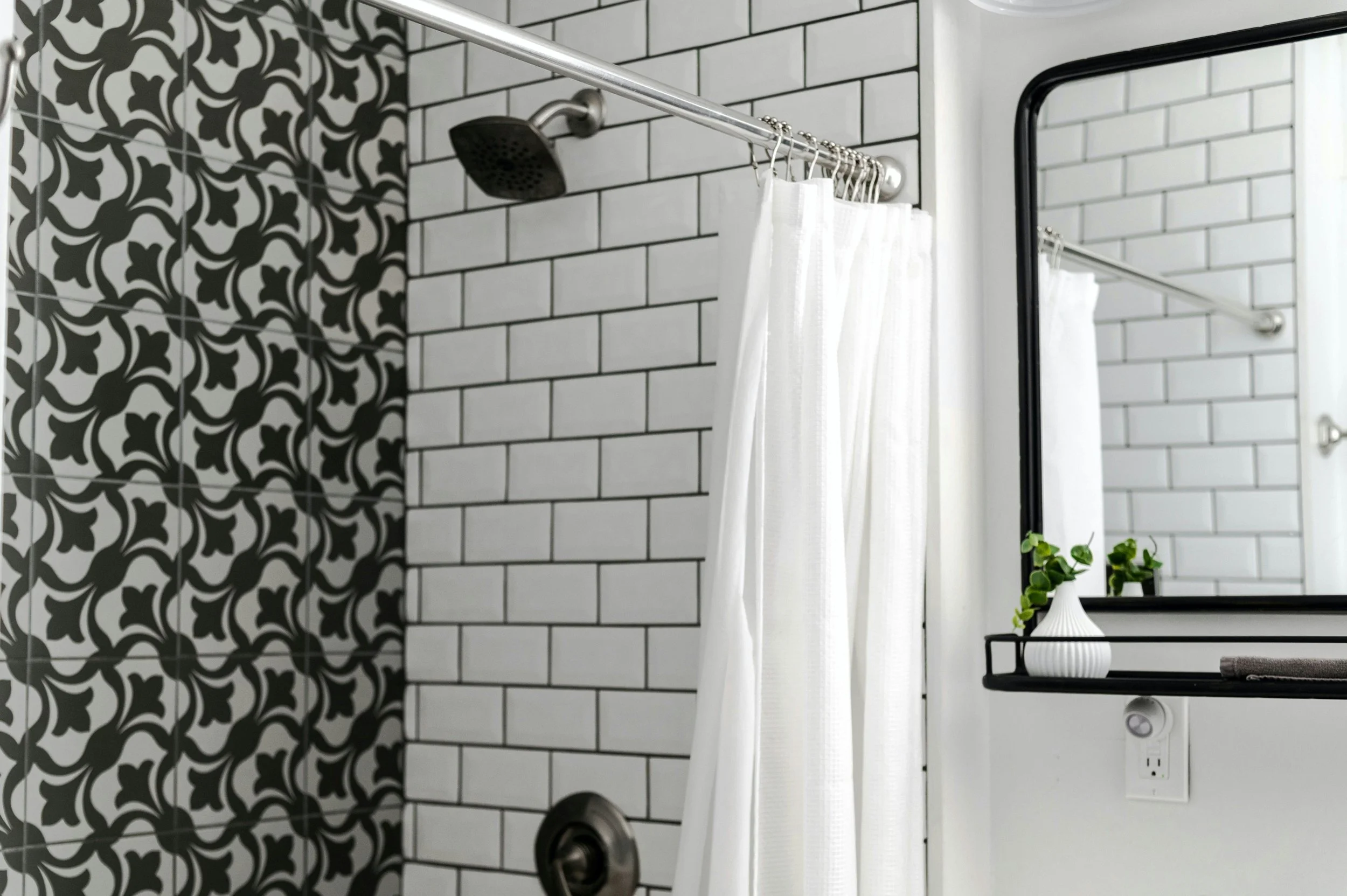A Healthier Bathroom Starts Here: The Role of Filters, Fabrics, and Fresh Air
Published October 2, 2025 by Meg Christensen, ND
When it comes to wellness, we often overlook one of the most frequently used spaces in our homes: the bathroom. Something as simple as your shower water or choice of towel can impact your well-being. Mold, chemical fumes, and harsh water lurking in your bathroom may trigger allergies or irritate your skin and lungs. The good news is that a few smart swaps, from installing a filter on your shower to choosing organic fabrics and improving ventilation, can make your bathroom a healthier haven. Let’s explore why shower filters, mindful fabric choices, and fresh air are vital for your health and wellness in the bathroom.
Cleaner Water for Better Showers
Do you ever take a hot shower and notice the strong smell of chlorine or experience dry, itchy skin afterward? Tap water often contains chlorine (used as a disinfectant) and other chemicals that can become problematic in a steamy shower. In hot water, chlorine vaporizes; inhaling these vapors in an enclosed shower stall may contribute to respiratory issues and fatigue over time. Chlorine is also a known skin irritant that strips away natural oils, leaving your skin and hair dry or irritated. If you have sensitive skin or conditions like eczema, chlorinated or hard water can be especially aggravating. In fact, dermatology research has shown that hard water (water high in minerals like calcium) leaves soap residue on the skin that disrupts the skin barrier, leading to dryness and irritation. Hard water can even worsen eczema and dull your hair’s luster.
This is where a shower filter comes in. Installing a filtered shower head (essentially a shower head filter that attaches to your fixture) is a simple upgrade with big health benefits. A quality shower filter uses media like activated carbon or KDF to remove chlorine, chloramines, and even some heavy metals from the water. By filtering out these harsh substances, you reduce what’s absorbed by your skin and lungs. Many people report that their skin feels softer and less irritated and their hair more manageable after switching to filtered water. This isn’t just anecdotal – one study found that washing with softened (filtered) water protected the skin’s moisture and left it cleaner, whereas hard water left a residue that irritated and dried out the skin. People often notice fewer issues with dry skin and brittle hair once they start using a shower filter.
Beyond chlorine, high-quality shower filters can also reduce other impurities. Some models target sediments, “forever chemicals” (like PFAS), heavy metals, and even disinfection byproducts that form from chlorine. These contaminants might not harm you immediately, but minimizing exposure is wise for long-term health. For instance, certain disinfection byproducts (like trihalomethanes) have potential links to health risks, so filtering them out of your shower water adds an extra layer of protection. As a bonus, filtering out minerals can alleviate the “hard water” effects, leaving you with less soap scum in your shower and softer laundry and towels.
How to get started: Consider installing a filtered shower head (many install in minutes with no special tools). If you enjoy baths, you can find bath faucet filters or even use the shower filter while filling the tub. Remember to change filter cartridges as recommended so that your shower filter keeps working effectively. With this one change, you’ll be bathing in cleaner, gentler water, a daily boost for your skin, hair, and lungs.
Learn more about choosing the right shower filter in my Ultimate Guide to Choosing the Best Filtered Shower Head.
Healthy Bathroom Fabrics: Towels Matter More Than You Think
What you wrap yourself in after that clean shower is just as important as the water itself. Your bath towels touch large areas of your skin every day, so their material and cleanliness can affect skin health (especially if you have allergies or sensitive skin). Unfortunately, not all towels are created equal. Many conventional bathroom towel options are made from chemically treated fabrics. Manufacturers may add “functional” finishes to towels, like odor-fighting antimicrobials or wrinkle-resistant treatments. The downside is these finishes often use toxic chemicals. For example, wrinkle-free towels (and other linens) are sometimes treated with formaldehyde resins, and stain-resistant or “antibacterial” fabrics can contain PFAS (the notorious “forever chemicals”). These substances don’t always wash out; studies have found that significant amounts of processing chemicals remain in fabrics even after multiple washes, meaning they can leach onto your skin or into the air. Formaldehyde, in particular, is a known irritant and allergen, and a common trigger for contact dermatitis (skin rash) in those allergic to it. If you’ve ever gotten a rash from new clothing or towels, leftover finishing chemicals could be to blame.
The safer choice (and what I recommend) is to switch to organic bathroom towels. These towels are usually made from organically grown cotton or linen and processed without the harsh chemicals. In other words, non-toxic towels that are free of harmful dyes, formaldehyde, and heavy metals. Look for third-party certifications like GOTS (Global Organic Textile Standard) or OEKO-TEX on towels, as these ensure the product has been tested for chemical safety. Such towels are not only gentler for sensitive skin (no chemical irritants) but often higher quality fiber that lasts longer.
Another perk of organic or non-toxic towels is that many are designed to be fast-drying. Natural materials like cotton and linen in breathable weaves (e.g. “waffle” weaves) dry quicker than extra-plush synthetics. Why does this matter? A damp towel that stays wet all day can become a breeding ground for mildew or bacteria, and it will make your bathroom more humid, potentially contributing to mold growth or that “musty” smell. A quick-drying towel, on the other hand, helps prevent these issues by not harboring moisture. (You should still hang up towels spread out on a bar or hook so they dry thoroughly between uses.) The Mayo Clinic’s home allergy guidelines even suggest avoiding thick carpets or fabrics in poorly ventilated bathrooms to reduce mold traps. So by picking an organic towel that’s free from chemicals and dries fast, you’re keeping both your skin and your bathroom environment healthier.
Tip: Wash new towels before first use to remove any residual manufacturing chemicals (organic towels typically have less, but it’s good practice). Use unscented or gentle laundry detergent to avoid re-depositing irritants. Replace towels when they become scratchy or retain odors that washing can’t remove: that can indicate fabric breakdown or microbial growth.
Ditch the Vinyl: Choosing a Non-Toxic Shower Curtain
If your bathroom has a shower curtain, take a moment to consider what it’s made of. That “new shower curtain smell” from a vinyl (PVC) curtain or liner isn’t just a harmless plastic odor, it’s actually chemicals volatilizing into your bathroom air. Many cheap vinyl shower curtains contain phthalates, which are plasticizer chemicals linked to hormone disruption and reproductive issues. Heat and humidity (like during a hot shower) can cause these compounds to off-gas into your bathroom air. In fact, researchers have measured dozens of volatile organic compounds (VOCs) coming from PVC shower curtains, some lingering in the air for more than a month after a curtain is unwrapped. The concern is that inhaling these VOCs (which may include not just phthalates but also additives like toluene, xylene, or even formaldehyde) can irritate your eyes, nose, and throat or contribute to headaches and asthma symptoms in sensitive people. The enclosed, often poorly ventilated bathroom is the last place you want to introduce unnecessary airborne toxins.
The solution is simple: opt for a non-toxic shower curtain. That means avoiding PVC/vinyl curtains altogether. Instead, look for safer materials like polyester, PEVA (a PVC-free plastic), or best of all, natural fibers. An organic shower curtain made of cotton, hemp, or linen is an excellent choice. These fabric curtains contain no chlorine-based plastics and thus don’t emit phthalates or the same level of VOCs. According to home health experts,polyester or natural fiber shower curtains are not only safer for your indoor air, but also tend to be more durable and easy to clean than vinyl. Many are machine-washable, so you can regularly wash out any soap scum or mildew; try doing this every few weeks to keep them fresh.
Even with a non-toxic curtain, mold and mildew can still be an issue if the curtain is perpetually damp. Bathrooms are humid environments, and a wet curtain (especially one that clings or folds on itself) is a prime spot for mildew growth. Mold spores on a shower curtain can become airborne and trigger allergies or asthma. To combat this, make sure to spread the curtain out across the rod after each use so it can dry. Good ventilation (more on that next) will also help. If you see any pinkish-orange biofilm or black spots developing, it’s time to wash the curtain or liner. The Mayo Clinic specifically advises to “clean or replace moldy shower curtains” as part of keeping a bathroom allergy-proof. With an organic fabric curtain, you can toss it in the wash with hot water and a little oxygen bleach to kill mold. No need to constantly buy disposable plastic liners!
In summary, your shower curtain should help keep water in the tub without polluting your air. By switching to a PVC-free, non-toxic shower curtain (like one made of organic cotton), you’ll eliminate a significant source of VOCs and potential endocrine disruptors from your daily routine. It’s a simple swap that lets you breathe easier (literally) every time you shower.
I’ve compiled some of the most trusted shower curtain options in my Guide to Non-Toxic Shower Curtains, including organic cotton designs.
Fresh Air and Fragrance: Ventilation is Vital
So far we’ve covered water and fabrics, and the last piece of the puzzle for a healthy bathroom is the air quality. Bathrooms can be notorious for odors, humidity, and lack of ventilation. A damp, unventilated bathroom doesn’t just feel icky; it creates ideal conditions for mold, mildew, and even dust mites, all of which can cause respiratory issues or allergies. If you’ve ever stepped into a bathroom that smells musty or “off,” that’s a red flag of poor air circulation and microbial growth. Here’s how to keep your bathroom air fresh and healthy:
1. Use that exhaust fan (or open a window): Proper ventilation is your first line of defense against excess moisture. Every time you shower or take a bath, run a vent fan that vents to the outside (not just recirculating) for at least 15–20 minutes. This helps expel humid air that would otherwise condense on walls and ceilings and foster mold. If your bathroom doesn’t have a fan, cracking open a window (weather permitting) can help release steam and bring in fresh air. Inadequate ventilation can lead to hidden mold colonies in walls or ceilings – one common issue is fans that vent into an attic or crawlspace, which simply moves moisture to another part of your home. Ensure your fan is vented outdoors and is powerful enough for the size of the room (measured in CFM). The Mayo Clinic and other health organizations emphasize bathroom ventilation as key to preventing mold and allergen buildup. In short: dry it out. After a shower, squeegee excess water off walls, hang up wet towels (fast-drying towels help here), and let the fan run to clear out humidity.
Another smart step is to use an indoor air quality monitor in your bathroom. These small devices can track humidity levels, temperature, and even VOCs (volatile organic compounds) in real time. By monitoring these factors, you’ll know if your bathroom is staying too damp, which increases the risk of mold, or if chemical cleaners and shower products are adding unnecessary pollutants to your air. Having concrete data makes it easier to take action, whether that means running the fan longer, opening a window, or swapping to gentler, non-toxic cleaning supplies.
Candles and sprays may smell relaxing, but many release hidden chemicals. Swap lab-made fragrances for non-toxic options and let your bath truly support your health.
2. Go easy on artificial fragrances: It might be tempting to spray air freshener or light a scented candle in the bathroom to mask odors. But many conventional air fresheners (sprays, plug-ins, scented oils) contain chemicals that can undermine the healthy environment you’re trying to create. A study by the NRDC found that 86% of air fresheners tested contained phthalates, the same hormone-disrupting chemicals we discussed in vinyl curtains. These products also emit VOCs like benzene, toluene, and even formaldehyde (a known carcinogen) into your indoor air. Such chemicals can irritate your eyes, skin, and lungs; trigger headaches; and exacerbate asthma. Ironically, a product meant to “freshen” the air can pollute your bathroom with a chemical cloud that lingers. One health advocacy group notes that even trace amounts of phthalates in air can cause allergic symptoms and asthma flare-ups. Clearly, “fresh-smelling” doesn’t always equal healthy.
A non-toxic home fragrance approach is much better for daily use. The simplest method is to avoid heavy scents entirely and rely on cleanliness and ventilation to keep odors in check. If you clean routinely and dry out the room, you shouldn’t need heavy fragrances. For a light scent, you can use natural options occasionally: for example, an essential oil diffuser with organic lavender or eucalyptus oil, a beeswax candle with an essential oil scent, or just a box of baking soda hidden behind the toilet to absorb odors. (Always be cautious with essential oils around pets or if you have sensitivities: “natural” substances can still irritate if overused.) Some people also like to leave a small bowl of white vinegar out for an hour, which can neutralize odors without adding new fragrances. The key is to remove the source of smells rather than just masking them. Ensure the toilet, drains, and trash bin are cleaned regularly. For persistent humidity smells, a dehumidifier or moisture absorber can help.
Your goal should be a bathroom that smells neutrally clean, not perfumed. Remember that good ventilation doubles as a natural air freshener. Nothing beats actual fresh air cycling through. Ultimately, creating a healthier bathroom is as much about what you don’t breathe in as what you do. By ventilating well and sticking to non-toxic fragrance choices, you’ll ensure that deep breath you take in the shower is doing your body good, not harm.
Open your windows and let your bathroom breathe. Good ventilation keeps moisture, odors, and toxins at bay, bringing in fresh air for a healthier home.
Your bathroom should be a place of refreshment, not a source of pollutants or health stressors. By using water filters to remove chlorine and irritants, choosing organic fabrics for your towels and shower curtain, and maintaining plenty of fresh air circulation, you can transform your bathroom into a truly healthy oasis. These changes are grounded in simple science, yet the payoff is significant. You may notice improvements in your skin and hair, fewer allergy flare-ups, or just an overall better feeling knowing that your daily routines are supporting your wellness.
I believe that prevention is powerful: removing harmful exposures in your home can help prevent certain skin problems, allergies, or respiratory issues down the line. A healthier life really can start in something as humble as your bathroom. So take a look around your bath space and consider making one or two of the upgrades discussed above.
Ready to take action? For product recommendations and reviews on creating a healthy bathroom, check out my Non Toxic Bathroom page. We’ve done the research to highlight the best shower filters, organic towels, non-toxic curtains, and more, so you can confidently choose items that are safe and effective. Here’s to a cleaner, greener, and healthier bathroom for you and your family!
Sources:
Mayo Clinic – Allergy-proof Your Home
Healthline – Do You Really Need Water Filters in Your Home? 3 Reasons Why It Could Be Helpful
This Old House – Ways Your Bathroom Is Making You Sick
WaterScience Blog – Why You Need a Shower Filter
IndoorDoctor – The Hidden Health Hazards of Plug-In Air Fresheners





